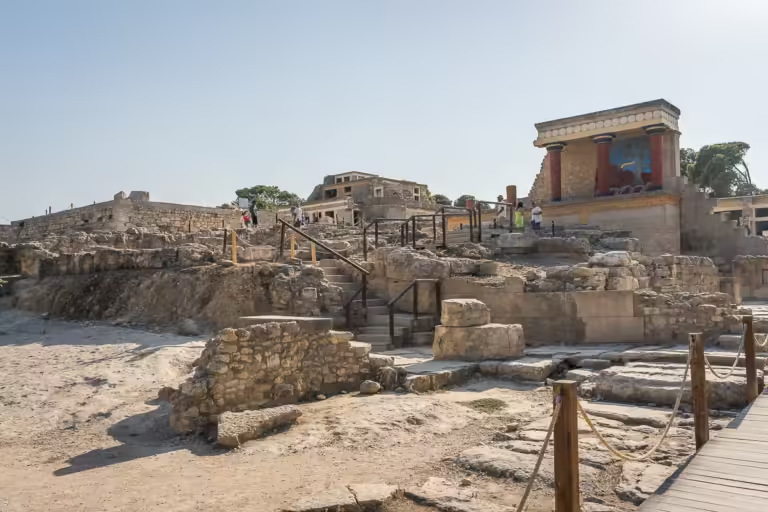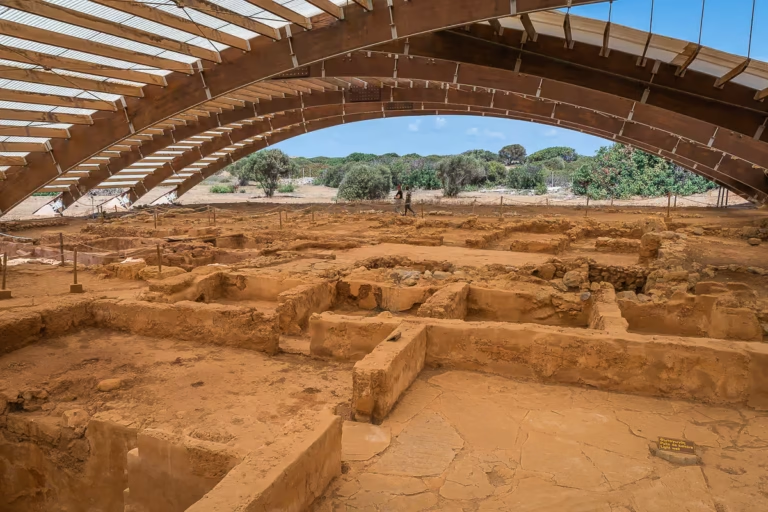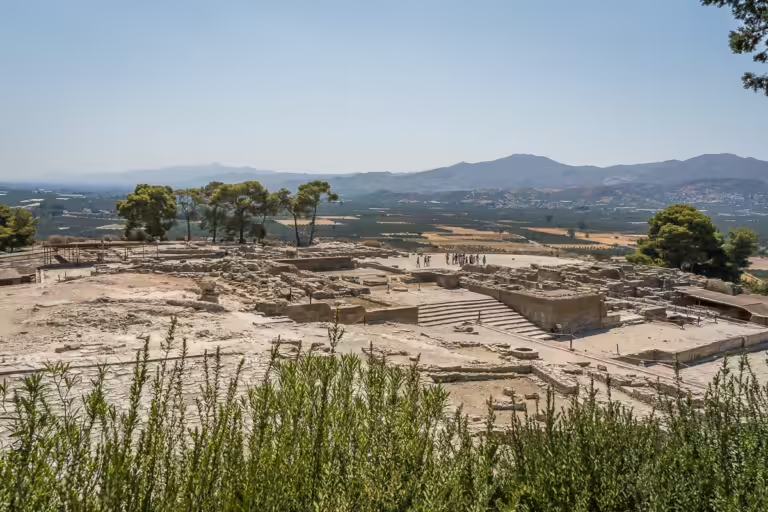Visiting The Minoan Palace of Zakros in Eastern Crete
This article contains affiliate links that may earn us a commission at no extra cost to you. Read our Affiliate Disclosure for more. Thanks for your support!
Surrounded by the raw beauty of Eastern Crete’s spectacular scenery, the Minoan Palace of Zakros is a hidden gem patiently waiting to be discovered by ancient history enthusiasts willing to reach the island’s easternmost edge.
The archaeological site of Zakros Palace is one of the least-visited ancient sites in Crete. Yet, it’s filled with wonders, and its breathtakingly beautiful location is certainly one of them.
Read this guide and get ready to dive deep into Minoan history at the once-mighty Minoan Palace of Zakros.

Where Is The Minoan Palace of Zakros?
Located on the eastern coast of Crete, the Minoan Palace of Zakros is a one-hour drive from Sitia, the island’s easternmost city.
Zakros Palace is in the Lasithi region, near the beach of Kato Zakros, which is why it’s sometimes called the Minoan Palace of Kato Zakros. The modern village of Zakros – also called Ano Zakros – is a 15-minute drive from the archaeological site of Zakros.
Timeline of The Minoan Palace of Zakros
The Minoan Palace of Zakros was constructed in two main building phases. The Old Palace dates back to 1900 BC, while the new one dates back to 1600 BC.
However, along with the other major palaces of the Minoan Civilization, it was destroyed in 1450 BC, marking the end of the Minoan Period and the beginning of the Mycenaean Civilization that was starting to emerge in mainland Greece.

Why Is Zakros Palace Important?
Although the smallest of all Minoan sites in Crete, Zakros Palace occupied an advantageous strategic position on Crete’s eastern tip.
Zakros was a powerful commercial center connected to hubs in the Eastern Mediterranean Sea, the Aegean Sea, and the other centers of Minoan Civilization.
The elephant tusks and bronze ingots (blocks of bronze that were used instead of money) found in the Palace’s West Wing verify the commercial relationships with countries of the East.
Furthermore, the second-largest number of Linear A clay tablets were found in the Minoan Palace of Zakros.
In addition, Zakros Palace was the only Minoan Palace that wasn’t pillaged after the Palace’s collapse, thus providing archaeologists with important information about life in Ancient Zakros.

Is The Archaeological Site of Zakros Worth Visiting?
The Palace of Zakros is one of the four known Minoan Palaces in Crete that have been excavated so far.
Thanks to its small size, Zakros Palace is perfect for understanding the architectural layout of a Minoan Palace and how this basic plan of all Minoan Palaces reflected the multiple functions of these magnificent buildings.
Minoan Palaces functioned not only as royal residences but also as religious and administrative centers. Any Minoan Palace would be divided into four wings set around a central courtyard, each with a different orientation: east, west, north, and south.
Aside from its historical value, another reason to visit Zakros Palace is its excellent location, near Kato Zakros Beach and the Gorge of The Dead.

FAQs About Visiting The Minoan Palace of Zakros
How long does it take to visit the Minoan Palace of Zakros?
The Palace complex is small. It takes between 30 and 45 minutes to explore the entire archaeological site of Zakros.
Is the Minoan Palace of Zakros accessible?
The designated walking route is flat near the Central Courtyard and the Palace ruins. There’s a smooth incline to reach the adjacent ruins of the Ancient Town. No paths are paved, and there are no ramps for wheelchair users.
Is there a parking lot at the Archaeological Site of Zakros?
Yes, there’s a parking space across the street from the main entrance of the archaeological site.
Are there any toilets or other facilities at the Minoan Palace of Zakros?
There are toilets near the ticket booth of the Zakros Archaeological Site.
Are there any restaurants near the Archaeological Site of Zakros?
Yes. A short walk from the archaeological site, there’s a beach lined with traditional restaurants and cafés.
We tried Platanakis Tavern, a family-run restaurant serving dishes made with fresh local ingredients. Savoring excellent food in a wonderful seaside setting like this is an experience we can’t recommend enough.
What is the best time to visit Zakros Palace?
The Minoan Palace of Zakros is open year-round. As it’s a lesser-known site, you don’t have to worry about crowds, not even during peak season. However, if you’re visiting during the summer, be aware that there’s no shade, so bring a hat and water.

What To See at The Minoan Palace of Zakros – Walking Route
We love archaeological sites in Greece but, sadly, not all of them are easy to navigate. First of all, there isn’t always a clear route to follow. Moreover, not all areas have informative signs and, when they do, sometimes these signs use difficult terminology.
Also, on-site maps often include monuments or points of interest that are no longer visible – because they’re either destroyed or covered by the modern city.
This section is meant to help you navigate any ancient site in Greece by providing a tested-by-us walking route of the most important monuments that you can actually see – rather than just imagine.
Furthermore, we replace the original scientific terms (here in brackets) with simple translations in English when necessary and provide context in cases where informative signs are scarce or non-existent.
Zakros Palace must have had at least two floors and over 300 rooms. Yet, nothing is left but scattered sun-drenched stones. Next to the Palace ruins lie the remains of the Minoan Town of Zakros.
There isn’t any reconstructed part in Zakros, only the ruins of the foundations. However, we hope this Zakros Palace walking route helps you understand how a Minoan Palace was arranged and functioned.
Minoan Palace of Zakros Map
Central Courtyard
After buying your tickets, the designated path will lead you to the Palace’s Central Courtyard. The Central Courtyard is typical of Minoan Palaces, as there’s one in every Minoan Palace. You can see that with your own eyes when you visit Phaistos Palace or explore Malia Palace.
The Central Courtyard is the heart of the Palace complex, which leads to four Wings that form a cross layout. From there, it’s easy to find your way around the Palace and also understand the various functions of each Wing.
Various Workshops occupied the South Wing, the West Wing was the Religious Center, the Kitchen was in the North Wing, and the Royal Quarters and Administrative Center were in the Eastern Wing.
At the northwestern corner, a Shrine underlines the religious character of the Courtyard.

Workshops – South Wing
Continue to the South Wing of Zakros Palace, where the Workshops once stood. With bronze tripods and heating pans, local craftsmen worked with marble, rock crystal, ivory, and other semi-precious stones to create unique artifacts or perfumes.
Religious Center – West Wing
The Religious Center occupied the West Wing of Zakros Palace. Its entrance was close to the Shrine in the Central Courtyard. The once richly decorated rooms on the West Wing’s facade were the most important rooms in this part of the Palace.
The largest room had a Lightwell. It was a hall reserved for religious ceremonies and activities. The Ceremonial Hall was connected to the Banquet Hall, where wine pots and jugs were found.

The smaller Sacred Rooms at the back of the Ceremonial and Banquet Halls had secondary uses, but they weren’t less important.
The Palace kept records of wine, agriculture products, and livestock on clay tablets written in Linear A script in the Archive Room.
Other rooms included a Storage Room for ritual pots, a small Shrine, and a small room where the underground Lustral Basin was located. Many valuable objects were found intact at the so-called Treasury of The Shrine.

Storerooms – West Wing
Next to the Religious Center, a small complex of rooms was used to store big jars. The small size of the Storerooms indicates that the economy of Zakros was mainly dependent on sea trade rather than agriculture.
Kitchen – North Wing
The North Wing was home to the Kitchen and Storage Rooms for utensils and supplies. A large staircase led to the Feast Hall on the upper floor.
Queen’s Bath -East Wing
Although not much is left from the King’s and Queen’s Royal Apartments, a part of the Queen’s Baths has survived.
A flight of stairs led to the subterranean Lustral Basin, which was used for purification rituals. On the benches around the walls, you can see some holes where columns used to be. Between the columns, the walls were decorated with frescoes.

Port Road
Walk past the East Wing of the Palace along the paved road that marked the boundary between the Palace complex and the Minoan Town. The road is called Port Road, as it led to Zakros Port.

Minoan Town
The Minoan Town was built on two hills around the Palace complex. The part of the Town south of the Palace is outside the current archaeological site, while the northern part is just above the Port Road.
Wander around the paved streets, explore the remains of the densely populated Town, and enjoy panoramic views of the archaeological site of Zakros.

Cistern Hall – East Wing
On your way back to the East Wing and the exit, an impressive water element of the Palace complex awaits. The Cistern is what remained of the once Great Hall of the Palace’s East Wing.
The column bases around the Cistern imply a shaft above the water letting the light majestically fill the Great Hall. The Cistern Hall could be similar to the Throne Room you’ll see when you visit Knossos Palace.
Nowadays, the permanent residents of the Cistern, cutie water turtles and fish, are among the indisputable attractions of the archaeological site of Zakros.

Elaborate Fountain – East Wing
A few steps from the Cistern Hall is the Elaborate Fountain, an underground rectangular cistern with 15 steps used for collecting water.

Well – East Wing
Right back where you started this walking route, you’ll see a circular Well that was used for pumping water back in the day.
One of the most mind-blowing archaeological finds was discovered in this Well during the 1960s excavations. It was an offering cup filled with olives that remained intact throughout the millennia.

Nikolaos Platon Bust
Before you leave, catch your breath in the shade next to the Bust of Nikolaos Platon, the archaeologist who excavated the archaeological site of Zakros in the 1960s.
The first excavations were conducted by David George Hogarth of the British School of Archaeology in the late 19th century. Nikolaos Platon picked up from where his British colleague left off.
Platon’s role was critical to the archaeological site’s present development. Most excavation finds are exhibited at the Heraklion Archaeological Museum and some at the Sitia Archaeological Museum.

Minoan Palace of Zakros Opening Hours
During the winter period:
November 1st to March 31st: 8.30 AM to 3.30 PM
On January 6th and Clean Monday (the sixth Monday before Palm Sunday, a moveable feast usually in March): 8 AM to 3 PM
During the summer period:
April 1st to October 31st: 8 AM to 6.30 PM
On Whit Monday (the first Monday after Pentecost, a moveable feast usually in June), August 15th, and October 28th: 8 AM to 6 PM
During Greek Easter:
Good Friday, Holy Saturday, Greek Easter Monday: 8 AM to 6 PM
On January 1st, March 25th, May 1st, Greek Easter Sunday, December 25th, and December 26th, the Archaeological Site of Zakros Palace is closed.
Minoan Palace of Zakros Entrance Fees
The full ticket price is 10 EUR. From November 1st to March 31st, the ticket costs 5 EUR instead.
Entrance is free on the following days: March 6th, April 18th, May 18th, the last weekend of September, October 28th, and the first Sunday of each month from November to March.
How To Get To The Minoan Palace of Zakros
By Car
The best way to get to Zakros Palace is by car, as public transportation is not frequent in this lesser-known and unspoiled part of Crete. The Minoan Palace of Zakros is a one-hour drive from Sitia, 45 minutes from Palekastro, and 15 minutes from the modern village of Zakros.
By KTEL Bus
There’s a bus running from Sitia to Zakros. However, bus itineraries are scarce, and the bus drops you off at the modern village of Zakros, which is a couple hours hike from Zakros Palace and Kato Zakros Beach through the Gorge of The Dead.
To make matters worse, bus routes and timetables are subject to change. Therefore, it’s best to contact KTEL Bus Heraklio Lasithi before you set off on this journey.

Where To Stay Near The Minoan Palace of Zakros
The wider region of Zakros is gorgeous, with many exciting things to do. Therefore, a great option is to stay in the modern village of Zakros or near the archaeological site and the beach of Kato Zakros.
Zakros is an excellent base to explore this part of the Lasithi region on a road trip. Alternatively, the best place to stay to discover Eastern Crete is the small city of Sitia, which has more hotel options.

Things To Do Near The Minoan Palace of Zakros
The most popular thing to do near the Minoan Palace of Zakros is to hike the Gorge of The Dead. The gorge was named after the Minoan Cemetery, where the inhabitants of Ancient Zakros were buried. The cemetery was located on the gorge’s slopes.
The trail starts from the modern village of Zakros. There’s a second entrance to the gorge on the main road, almost halfway from the village of Zakros to Zakros Palace. If you choose the latter, the hike will be significantly shorter.
We chose the shorter route as we were hiking with friends and their kid. It took us about an hour to reach the end of the gorge, near Kato Zakros Beach. Besides a steep descent at the start of the trail, it’s an easy hike, more of a pleasant walk, really.

Zakros Beach is the perfect place to enjoy a delicious lunch and relax on the beach. However, the rocky seabed is not ideal for swimming. On the other hand, the nearby beaches of Xerokambos are among the best beaches in Crete.
Needless to say, the modern village of Zakros is worth a stop as there are a couple of traditional taverns with good quality local food there. You can also take a short, refreshing walk to the Natural Spring of Zakros.

We hope you enjoyed this virtual trip to the lesser-known Minoan Palace of Zakros. If you like to hear more about hidden ancient treasures, myths, and legends, we’d love you to join our Ancient Greece-themed Facebook group!



